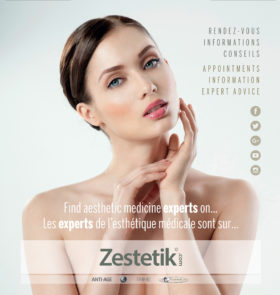By Doctor Valéria Romano
 Mirror, mirror on the wall, who is the fairest one of all? All women want to be the fairest in the kingdom, and cosmetic medicine and surgery were dreamt up to respond to this demand.
Mirror, mirror on the wall, who is the fairest one of all? All women want to be the fairest in the kingdom, and cosmetic medicine and surgery were dreamt up to respond to this demand.
Fillers, also called injectables, are an inescapable cornerstone of aesthetic medicine.
Principles
In 1934, hyaluronic acid was discovered in the vitreous humour of a bull’s eye, and the exceptional properties of this molecule determined its use in numerous medical specialities, in particular ophthalmology (cataract surgery), ENT (vocal cord surgery), urology, and in helping wounds to heal. The hyaluronic acid used in aesthetics is chemically synthetised: it is a medical device with the CE marking (European Conformity).
Different results: different products and different practitioners
The results achieved depend on the doctor performing the injections and on the product used.
The products differ with regard to their:
- Hydrophilicity: the product’s ability to attract water. In the under-eye area, for example, we need to use a minimally-hydrophilic product, as even a technically-flawless injection using a product that is too hydrophilic could be disastrous.
- Firmness: A firm product does not move, it does not migrate.
- Volumising effect: A product with large particles will lift the tissues more, and should not be used for the lips, for example.
- Cross-linking: The more cross-linked the product is, the longer it lasts.
The doctor performing the injections is 98% responsible for the result. Practitioners differ due to their:
- Ability to listen and understand the patient’s request. Understanding the patient’s expectations and desires is the first step towards successful injections.
- Technical ability: The importance of this is obvious, but we must also remember that a perfectly-mastered technique reduces the side-effects (bruising, swelling)
- The quantity of product injected: The correct amount of product should be injected exactly where it is needed, no more and no less.
- The depth of injection: superficial or deep. The depth should be adapted according to the indication (for under-eye bags, for example, the injection should be deep, right to the bone)
- The injection technique
- The sites injected

Indications
Fillers are a multipurpose tool.
In the face, they are used to create volumes (lips, cheekbones, under-eye area), treat hollows or grooves (nasolabial folds, marionette lines), or to lift the face (eyebrow lift, medical face lift).
They are used to improve the signs of aging, in particular to rejuvenate the neck, décolletage and hands.
They are injected into the body, either to create volume (Macrolane™) or to improve sagging or crinkled skin.
Genital aesthetics is enjoying a boom in popularity, with injections into the glans for aesthetic and medical purposes (treatment of premature ejaculation) and injections into the G-spot, labia majora and penis.
Fillers are also used for comfort, in particular injections into the soles of the feet to reduce the pain caused by wearing high heels, called a foot lift or “Loub job”.
 By Doctor Valéria Romano
By Doctor Valéria Romano
Former Paris Hospitals resident doctor. Degrees in anti-aging and morphological medicine, medical lasers, surgical dermatology, mesotherapy, the treatment of hair loss, and the evaluation of injection and filler techniques, in dermatology and plastic surgery. Member of the French Aesthetic Medicine Society (SFME), the Francophone Society for Medical Lasers (SFLM), the Advanced Society of Aesthetic and Plastic Medicine and Surgery (SAMCEP), the French Mesotherapy Society (SFM), the European LED Academy, and the World Society of Interdisciplinary Anti-Aging Medicine.







